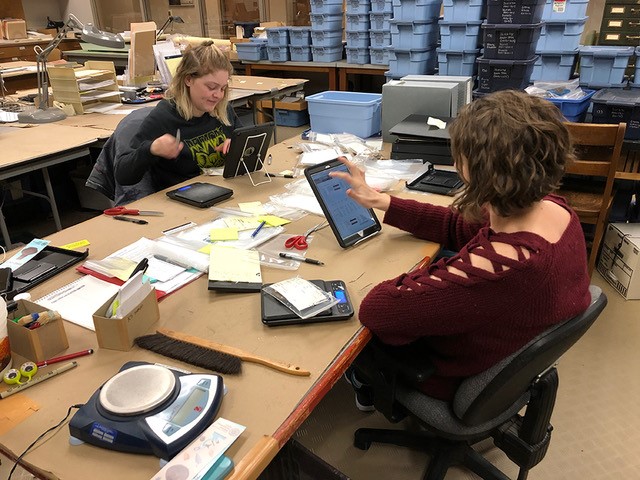“Preserving and Presenting Arkansas History through Artifacts,” funded by a FY 2019 grant from the Arkansas Natural and Cultural Resources Council (ANCRC), initiates a long-term effort to create updated and comprehensive inventory information on artifact collections housed in the Arkansas Archeological Survey’s Coordinating Office (ARAS-CO) in Fayetteville. Collections selected for this project have significant potential for research and/or public outreach applications based on collection content and quality of associated documentation.

Project archeologists Madelyn Rose and Dr. Michelle Rathgaber, with help from summer intern Katherine Bryles, began the process by logging artifact collections into a database accessible via a new tablet-based artifact cataloging system that was developed by our Digital Data Collection Initiative team to digitize both field and lab documentation processes. The team logged 25,152 entries, representing more than 146,462 artifacts from four collections. This count excludes small non-diagnostic materials, and soil and flotation samples that are not individually counted but logged by weight. Each database entry includes three-dimensional (X, Y, Z) provenience coordinates for all artifacts using northing and easting data as well as excavation depth, along with material type, quantity, weight, and prehistoric category or historic function. Artifacts are packaged in new, archival quality zip-lock bags and then placed into labeled, 3-gallon Rubbermaid containers. Artifacts that are unique, have visible writing or decoration, or are otherwise diagnostic, are photographed and image files are linked to the database entry. Storage location at the ARAS-CO is also logged for future reference.
Site/Project Collections
The River Mountain Pumped Storage collection consists of materials from two projects incorporating artifacts excavated from seven Logan County sites investigated by a private Cultural Resource Management contracting firm as part of a federally authorized water treatment facility development. The project was cancelled before completion; consequently, a final archeological report was never completed even though substantial excavations had been conducted, producing extensive artifact collections from well-understood contexts. One collection from the Roberts site (3LO231) represents a late 19th to early 20th century rural mountain-top farmstead occupation on the south side of the Arkansas River. This is a site category underrepresented in that region’s archeological record. Oral history interviews also suggested that an “Old Indian Campground” existed at the site, thought to be a late 19th century occupation associated with Cherokee or Choctaw settlement. With the abrupt termination of the project, the artifact collection was not adequately inventoried when it was transferred to ARAS for permanent curation. Nor was it appropriately boxed; storage materials did not meet curatorial guidelines and oversize containers took up far more shelf space than necessary. In view of these circumstances and the collection’s historical significance, it was selected for processing as part of this project.

The Saltpeter Cave collection is the subject of an ongoing ARAS lab study. Saltpeter Cave (3NW0029) is a deeply stratified bluff shelter located in Newton County, excavated during the early 1970s by Ken Cole (ARAS). Cole excavated undisturbed deposits extending some 14 feet in depth, representing more than 8,000 years of Native American history. These excavations represent the first application of modern techniques and standards following the 1930s-era bluff shelter excavations conducted by University of Arkansas Museum crews working under the direction of Samuel Dellinger (Mainfort 2008). ANCRC awarded funds to support a comprehensive inventory and preliminary analysis of this material during FY 2017 (ANCRC 2017-06). As part of the current project, we input the previously documented inventory into the new catalog system to facilitate further analysis, report preparation, and public outreach activities. The Saltpeter Cave material represents a mid-sized collection that allowed us to troubleshoot prehistoric artifact categories and data entry procedures in the new system.
The Goldsmith Oliver II Mitigation collection from 3PU030 is derived from two projects. Initial testing of the site, located near the Clinton National Airport in Little Rock, identified the presence of significant buried cultural features that were then excavated as part of a subsequent project phase. The excavated materials have been analyzed and a final project report was written and submitted to the Federal Aviation Administration (Jeter, Cande, and Mintz 1990). The collection was brought up to Survey curation standards in this project, items subject to the Native American Graves Protection and Repatriation Act (NAGPRA) were removed for repatriation, and the artifacts were logged into the database for further analysis. The importance of this collection stems from the fact that it is a contact period site that contributes significantly to our understanding of Native American and European interactions in colonial Arkansas.
The Albertson Site (3BE0174) is a bluff shelter excavated during the late 1960s by Arkansas Archeological Society member Don R. Dickson. Though modest in floor area, the site had impressively deep, stratified deposits representing approximately 10,000 years of occupation. The collection had been partially analyzed and reported (Dickson 1991), but a substantial portion of the collection had never been washed, sorted, or cataloged. The unprocessed materials were included in this project to bring the collection up to ARAS curation standards. The ARAS-UAF research station has undertaken a new project to reexamine bluff shelters and their contents, so it was useful to incorporate a collection like this one into our new inventory process, to troubleshoot differences in data entry among multiple analysts.
Refinements Accomplished Using the New ARAS Tablet-Based Cataloging System

